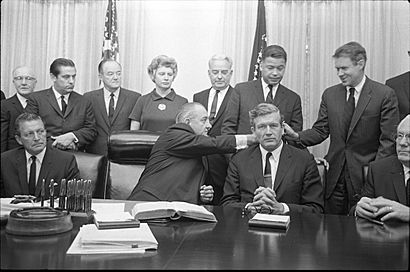Kerner Commission facts for kids
| National Advisory Commission on Civil Disorders | |
 |
|

President Lyndon Baines Johnson with some members of the National Advisory Commission on Civil Disorders (Kerner Commission) in the Cabinet Room of the White House, Washington, D.C.
|
|
| History | |
|---|---|
| Status | Defunct |
| Established by | [[{{#property:P170}}]] on {{#property:P571}} |
| Disbanded | {{#property:P576}} |
| Related Executive Order number(s) | {{#property:P1555}} |
| Membership | |
| Chairperson | [[{{#property:P488}}]] |
| Jurisdiction | |
| Purpose | Investigate the causes of a recent outbreak of race riots, with a particular focus on the 1967 Detroit riots. |
The National Advisory Commission on Civil Disorders, often called the Kerner Commission, was a special group created in July 1967. It was named after its leader, Governor Otto Kerner Jr. of Illinois. President Lyndon B. Johnson formed this 11-member commission. Its main job was to figure out why over 150 riots happened across the country in 1967. The commission also had to suggest ways to stop them from happening again.
After seven months of work, the commission released its report in 1968. Many people thought the riots were caused by a few troublemakers. But the commission found something different. They said the riots were a reaction to many years of "widespread unfair treatment and separation." The report stated that "White racism is essentially responsible" for the problems in cities. It explained that white society created and kept up the difficult conditions in Black neighborhoods.
The commission's 426-page report is seen as a very important document about race relations in the United States. It became a bestseller, selling more copies than the report about President Kennedy's assassination.
Contents
Why Was the Commission Formed?
President Johnson created the Kerner Commission on July 28, 1967. At that time, a major riot was still happening in Detroit. Since 1965, there had been growing unrest in some Black and Puerto Rican neighborhoods. But the events of 1967 were especially shocking. News reports often showed National Guardsmen and police. There were also images of tanks, huge fires, and damaged buildings.
When President Johnson signed the order to create the commission, he asked three key questions. He wanted to know: "What happened?" "Why did it happen?" And "What can be done to prevent it from happening again?"
How the Commission Worked
David Ginsburg was chosen to lead the commission's daily work. He quickly hired about 200 staff members. They developed a detailed plan to investigate the riots. This plan included looking at information from 13,000 people arrested during the riots. Teams also visited over twenty cities. They interviewed police and local officials. They used FBI reports and studied population data. They also talked to people living in the riot areas.
The commission also got help from other groups. One was the National Advisory Panel on Insurance. This group looked at why insurance companies were leaving minority areas. Their ideas were included in the Kerner Report. Another group focused on how businesses could help. They looked for ways to encourage companies to hire low-income workers. They also explored how businesses could move into or grow in low-income areas. Their suggestions were also part of the Kerner Report.
Key Findings of the Report
The Kerner Report was officially released on February 29, 1968. It quickly became a huge success. More than two million people bought copies of the report. Its main finding was that the riots happened because Black people felt frustrated. They lacked good job opportunities. They also felt unfairly treated by white society, especially by the police. Martin Luther King Jr. called the report "a physician's warning." He said it offered "a prescription for life."
The report criticized both federal and state governments. It said their policies on housing, education, and social services had failed. The report also strongly criticized the media. It said the press had "too long basked in a white world." It viewed things "with white men's eyes and white perspective." The report described how eight riots unfolded. It also included government numbers showing the differences in living conditions. These differences were between Black and white Americans.
The report's most famous line warned: "Our nation is moving toward two societies, one black, one white—separate and unequal."
It concluded that the main reason for the violence was white racism. It suggested that white America was largely responsible for the Black riots. The study of arrested rioters showed they were not outsiders or criminals. Instead, they usually lived in the city where they rioted. They had stayed in school a bit longer than average. They also had jobs, even if they didn't pay well. The commission found no proof of any conspiracy behind the riots.
The report called for several big changes. These included ending segregation that happened in practice. It also asked for new jobs and housing. It suggested major changes to welfare programs. Finally, it called for more diversity in local police forces and the media.
The commission also pointed out that:
- Cities would likely have Black majorities by 1985.
- Suburbs around these cities would likely stay mostly white.
- New housing programs should focus on smaller units. These should be built in different locations, not just large, high-rise projects in poor areas.
What Happened After the Report?
In April 1968, just one month after the report came out, Martin Luther King, Jr. was assassinated. This led to riots of protest and sadness in over 100 cities. Many people feared this meant years of violence. However, major riots mostly stopped after 1968. It wasn't until 1980 that a large riot happened again in Miami. Then, twelve more years passed until the Rodney King riot in Los Angeles.
Many people believe that much of the Kerner Report has been ignored. Its suggestions have not been fully put into action. For example, programs like Head Start have not received the funding the commission wanted. Also, major welfare and job training ideas have not been adopted. It might be more accurate to say that the report's ideas have not been carried out with the urgency it suggested.
Continuing the Commission's Work
The Milton S. Eisenhower Foundation was started in 1981. It aimed to support the findings of the Kerner Commission. Key members of the Kerner Commission helped create this foundation. The Eisenhower Foundation has released updates on the Kerner Report over the years. These updates came out for the 25th, 30th, and 40th anniversaries.
For the 30th anniversary in 1998, the Eisenhower Foundation sponsored two reports. These reports found that the racial divide had grown. Unemployment in inner cities was at very high levels. One report noted that America made progress on race, poverty, and inner cities for about a decade after the Kerner Report. But then, progress stopped or even went backward.
Commission Members
Main Commission
- Otto Kerner, Governor of Illinois (chairman)
- John Lindsay, Mayor of New York (vice chairman)
- Edward Brooke, Senator (R-MA)
- Fred R. Harris, Senator (D-OK)
- James Corman, Congressman (D-CA)
- William McCulloch, Congressman (R-OH)
- Charles Thornton, Founder of Litton Industries
- Roy Wilkins, leader of the NAACP
- I.W. Abel, President of United Steelworkers of America
- Herbert Turner Jenkins, Police chief, Atlanta, Georgia
- Katherine Graham Peden, Commissioner of Commerce, Kentucky
- David Ginsburg, Commission Executive Director
See also
- Moynihan Report
- President's Commission on Campus Unrest
- Investigation of the Watts Riots by the McCone Commission

